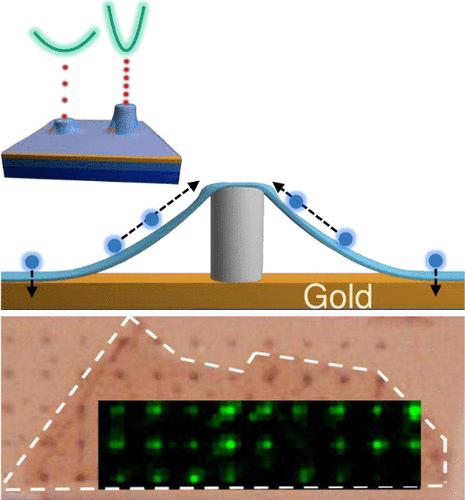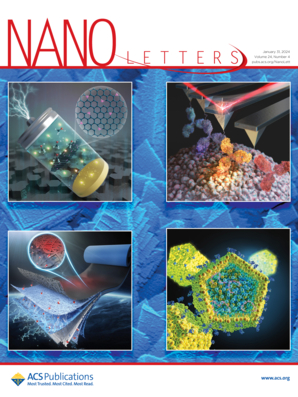在金属上使用高宽比纳米柱阵列同时提高 WSe2 单光子发射器的亮度和纯度
IF 9.6
1区 材料科学
Q1 CHEMISTRY, MULTIDISCIPLINARY
引用次数: 0
摘要
在纳米柱阵列上转移的单层半导体可提供现场控制的片上单光子发射,是量子技术的可扩展光源平台。然而,迄今报道的这些发射器的亮度往往达不到此类应用的预期要求。而且,单光子纯度通常会随着亮度的增加而降低。因此,需要一种设计方法来实现更高的发射率,同时保持较高的单光子纯度。通过在高光谱比(∼3,比以前的报告至少高出 2 倍)纳米柱阵列上使用 WSe2,我们在这里展示了 770-800 纳米波段的 10 MHz 单光子发射率,该发射率与量子存储器和中继器网络(Rb-87-D1/D2 线路)以及卫星量子通信兼容。这种发射器具有出色的纯度(即使在高发射率情况下),并且由于使用了金背反射器来淬灭远离纳米柱的发射,从而改善了外耦合。本文章由计算机程序翻译,如有差异,请以英文原文为准。

Simultaneously Enhancing Brightness and Purity of WSe2 Single Photon Emitter Using High-Aspect-Ratio Nanopillar Array on Metal
A monolayer semiconductor transferred on nanopillar arrays provides site-controlled, on-chip single photon emission, which is a scalable light source platform for quantum technologies. However, the brightness of these emitters reported to date often falls short of the perceived requirement for such applications. Also, the single photon purity usually degrades as the brightness increases. Hence, there is a need for a design methodology to achieve an enhanced emission rate while maintaining high single photon purity. By using WSe2 on high-aspect-ratio (∼3, at least 2-fold higher than previous reports) nanopillar arrays, here we demonstrate >10 MHz single photon emission rate in the 770–800 nm band that is compatible with quantum memory and repeater networks (Rb-87-D1/D2 lines) and satellite quantum communication. The emitters exhibit excellent purity (even at high emission rates) and improved out-coupling due to the use of a gold back reflector that quenches the emission away from the nanopillar.
求助全文
通过发布文献求助,成功后即可免费获取论文全文。
去求助
来源期刊

Nano Letters
工程技术-材料科学:综合
CiteScore
16.80
自引率
2.80%
发文量
1182
审稿时长
1.4 months
期刊介绍:
Nano Letters serves as a dynamic platform for promptly disseminating original results in fundamental, applied, and emerging research across all facets of nanoscience and nanotechnology. A pivotal criterion for inclusion within Nano Letters is the convergence of at least two different areas or disciplines, ensuring a rich interdisciplinary scope. The journal is dedicated to fostering exploration in diverse areas, including:
- Experimental and theoretical findings on physical, chemical, and biological phenomena at the nanoscale
- Synthesis, characterization, and processing of organic, inorganic, polymer, and hybrid nanomaterials through physical, chemical, and biological methodologies
- Modeling and simulation of synthetic, assembly, and interaction processes
- Realization of integrated nanostructures and nano-engineered devices exhibiting advanced performance
- Applications of nanoscale materials in living and environmental systems
Nano Letters is committed to advancing and showcasing groundbreaking research that intersects various domains, fostering innovation and collaboration in the ever-evolving field of nanoscience and nanotechnology.
 求助内容:
求助内容: 应助结果提醒方式:
应助结果提醒方式:


